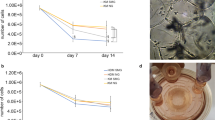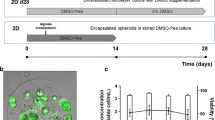Abstract
To develop three-dimensional (3D) cytotoxicity models further, microcystin-induced cytoskeletal disruption was tested in two different models of multicellular hepatocyte aggregate formation (hepatospheroids). Rat hepatocyte suspensions were seeded either onto poly(2-hydroxyethylmethacrylate)-treated culture wells (poly-HEMA) or in a rotating wall vessel (RWV) device which provides minimal shear forces and enhances differentiated 3D growth.
Ninety percent of spheroids forming on poly-HEMA tended to fuse and form nonhomogeneous multilobular structures by day 4 of incubation. In contrast, spheroids cultured in the low-shear environment formed homogeneous aggregates that averaged 126±10 μm diameter in size at day 7. Microcystin-LR (10–6 mol/L) was put into contact (90 min in serum- free medium) with hepatocyte suspensions and spheroids formed in both systems for 1, 4 or 7 days. As already described, microcystin-LR (after 90 min), induced cytoskeletal disruptions (blebs) in 98% of the isolated primary hepatocytes maintained in suspension. In 3D cultures, blebs were detected only on poly-HEMA nonhomogeneous early prespheroids. All other mature spheroids (poly- HEMA or RWV) exposed to the toxin did not exhibit obvious morphological signs of toxicity. Moreover, microcystin-LR pre- incubation with hepatocyte suspension prevented the formation of conventional spheroids. In conclusion, the low-shear, simulated- microgravity environment generated high yields of regularly engineered spheroids. In both models, progressive resistance of mature spheroids to microcystin-LR-induced cell deformation developed with time in culture. Microcystin-LR inhibition of the formation of rat hepatospheroids in isolated hepatocyte suspension could be used as a complementary biological assay for detection of the presence of biologically active microcystin-LR in water samples.
Similar content being viewed by others
References
Battle T, Touchard C, Moulsdale HJ, Dowsett B, Stacey GN. New cell substrates for in vitro evaluation of microcystin hepato-cytotoxicity. Toxicol in Vitro. 1997;11:557-67.
Berg K, Aune T. Freshly prepared hepatocytes used in screening the toxicity of blue-green algal blooms. J Toxicol. 1987;20:187-97.
Duray PH, Hatfill SJ, Pellis NR. Tissue culture in microgravity. Sci Med. 1997;4:46-55.
Eriksson JE, Gronberg L, Nygard S, Slotte JP, Meriluoto JOA. Hepatocellular uptake of 3H-dihydromicrocystin-LR, a cyclic peptide toxin. Biochim Biophys Acta. 1990;1025:60-6.
Föllmann W, Petzinger E, Kinne RKH. Alterations of bile acid and bumetamide uptake during culturing of rat hepatocytes. Am J Physiol. 1990;258(Cell Physiol.27): C700-12.
Freed LE, Vunjak-Novakovic G. Microgravity tissue engineering. In Vitro Cell Dev Biol — Animal. 1997;33:381-5.
Goodwin TJ, Prewett TL, Wolf DA, Spaulding GF. Reduced shear stress: a major component in the ability of mammalian tissues to form three-dimensional assemblies in simulated microgravity. J Cell Biochem. 1993;51:301-11.
Hamilton G, Atterwill C, Wilcox P, George E. Comparison of different media for liver spheroid culture. Proceedings of the International Congress on the use of Hepatocytes: Application to cell Biology, Toxicology and Medicine. Tübingen, Germany, 25–28 September 1996. Cell Biology and Toxicology. Dordrecht: Kluwer Academic Publishers; 1996:12.
Koide N, Sakaguchi K, Koide Y et al. Formation of multicellular spheroids composed of adult rat hepatocytes in dishes with positively charged surfaces and under other non-adherent environments. Exp Cell Res. 1990;186:227-35.
Lazar A, Peshwa MV, Wu FJ, Chi CM, Cerra FB, Hu WS. Formation of porcine hepatocyte spheroids for use in a bioartificial liver. Cell Transplant. 1995;4:259-68.
Matsushima-Nishiwaki R, Shidoji Y, Nishiwaki S, Yamada T, Moriwaki H, Muto Y. Suppression by carotenoids of microcystin-induced morphological changes in mouse hepatocytes. Lipids. 1995;30:1029-34.
Peshwa MV, Wu FJ, Sharp HL, Cerra FB, Hu WS. Mechanistics of formation and ultrastructural evaluation of hepatocyte spheroids. In Vitro Cell Dev Biol — Animal. 1996;32:197-203.
Powers MJ, Rodriguez RE, Griffith LG. Cell-substratum adhesion strength as a determinant of hepatocyte aggregate morphology. Biotech Bioeng. 1997;53:415-26.
Prewett TL, Goodwin TJ, Spaulding GF. Three-dimensional modelling of T-24 human bladder carcinoma cell line: a new simulated microgravity culture system. J Tiss Cult Methods. 1993;15:29-36.
Rogiers V, Blaauboer B, Maurel P, Phillips I, Shephard E. Hepatocyte-based in vitro models and their application in pharmacotoxicology. Toxicol in Vitro. 1995;9:685-94.
Seglen PO. Preparation of isolated rat liver cells. Methods Cell Biol. 1976;19:29-83.
Schwarz RP, Goodwin TJ, Wolf DA. Cell culture for three-dimensional modelling in rotating wall vessels: an application of simulated microgravity. J Tiss Cult Methods. 1992; 14:51-8.
Wickstrom ML, Khan SA, Haschek WM et al. Alterations in microtubules, intermediate filaments and microfilaments induced by microcystin-LR in cultured cells. Toxicol Pathol. 1995;23:326-37.
Wu FJ, Friend JR, Hsiao CC et al. Efficient assembly of rat hepatocyte spheroids for tissue engineering applications. Biotech Bioeng. 1996;50:404-15.
Author information
Authors and Affiliations
Rights and permissions
About this article
Cite this article
Battle, T., Maguire, T., Moulsdale, H. et al. Progressive maturation resistance to microcystin-LR cytotoxicity in two different hepatospheroidal models. Cell Biol Toxicol 15, 3–12 (1999). https://doi.org/10.1023/A:1007587304619
Issue Date:
DOI: https://doi.org/10.1023/A:1007587304619




